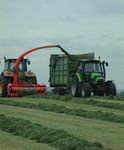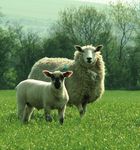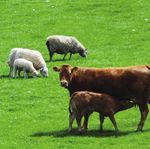Management and Control of Common (Soft) Rush
←
→
Page content transcription
If your browser does not render page correctly, please read the page content below
Management and Control
of Common (Soft) Rush
Information provided by Ian Cairns, Principal Consultant,
SAC Consulting.
Key messages
+ Long term control of + Grazing management
common rush can only be has a significant effect on
achieved by addressing rush competition. Grazing
underlying soil problems during the late spring and
such as drainage, soil early summer will help
acidity and soil fertility. control its spread. However,
heavy grazing during
+ Mechanical topping can
late autumn and winter
have a key role in rush
may cause poaching and
management by either
compaction, encouraging
removing rush cover to
the germination of dormant
allow further treatment, or
rush seeds the following
for annual control of light
spring.
infestations.
+ Well-timed application of + The control strategy
adopted on individual
glyphosate through a weed
farms must focus on priority
wiper can be an important
production areas and
part of a control strategy.
should take account of
It is particularly effective
agri-environmental scheme
when applied to green rush
and wildlife requirements.
regrowth after topping or
mowing.
+ Competition from grass
and clover will help reduce
re-infestation in a productive
sward after the initial rush
control programme has
been carried out.
Keywords:
Common rush, soft rush, rush control, Juncus effusus
1 of 6
www.eblex.org.uk advanced information from BRPContents Introduction
Common rush (Juncus effusus) infestation is mainly
How infestations arise 3 a problem in permanent pastures and rough grazings
on poorly drained soils in high rainfall areas. In
Preventing infestation 3 practice, these conditions are found mainly in
marginal and reclaimed upland areas in the north and
Controlling common rush on west of England.
improved grassland 3 Once established, rush plants can impede soil
drainage and reduce sward productivity. Where silage
is made they can affect consolidation in the pit or
Cost-effective, integrated control bale reducing the fermentation quality.
strategies 4
Case study 5
A 15% rush infestation in a productive grass sward,
could reduce output by 1.25t DM/ha/annum. If the
field is cut for big bale silage on upland in-bye fields,
the value of this lost production could be as high as
£192/ha (£78/acre).
Recent wet winters and summers have provided ideal
rush growing conditions and severely limited the
opportunity to control infestations.
2 of 6
www.eblex.org.uk advanced information from BRPHow infestations arise
Common rush seeds can lie dormant in soils for up to 60 years. Dormancy may be
broken allowing germination to occur after surface disturbance during cultivation, or
after surface poaching by livestock in wet weather.
A single rush seed head can produce up to 8,500 seeds a year, which are light and
easily dispersed in the wind. It is very important to take action quickly to prevent rapid
infestation.
Rush plants are often found in clumps in the wettest areas of fields, such as alongside
watercourses or in low-lying, boggy areas. If unchecked, spread can occur to the
remainder of the field or to neighbouring land.
Preventing infestation
The level of infestation or spread can be controlled by good management:
++ Avoid damaging grass swards by overgrazing, which can lead to poaching and
bare patches where rush seeds can establish
++ Maintain good drainage and remove soil compaction at the surface or within
the soil profile
++ Maintain soil fertility and soil pH to encourage good grass growth
++ Sow grass seed mixtures which are persistent and tiller aggressively which will
aid quick establishment and provide competition to the rush seedlings
Controlling common rush on improved grassland
Topping with a rotary or flail mower before the rush plants produce seed, can help
slow the rate of spread of infestation. It can also be useful in encouraging leafy growth
before chemical treatment.
Topping should take place before the seed produced that year becomes viable, ie in late
Topping should take place before spring or early summer.
the seed produced that year
becomes viable, ie in late spring or
early summer. Treating severe infestations like this can create a thick mulch of dead rush plants, which
will reduce grass competition and encourage rush seedling establishment. On flat and
stone-free land, large areas of rushes may be best tackled by drum/disc mowing, with
the cut material baled and removed.
Good grazing management is a key to prolonging the life of grass swards and prevent
weed infestation. The aim is to avoid excessive winter grazing, but to graze hard,
topping if necessary, in late spring and summer.
Note this strategy may be at odds with agri-environment scheme management
options, which require undisturbed swards during this period for nesting birds and chick
cover.
Less selective grazing animals, such as cattle, will help prevent re-infestation, due to
their grazing and trampling effect on young rush plants.
Top with a rotary or flail mower before
the rush plants produce seed Chemical control can be effective in widely-scattered and light infestations.
Glyphosate can be applied through a weed wiper, where rush plants are actively
growing and stand higher than the surrounding grass, eg after cattle or sheep have been
removed. In particularly dense infestations, wiping in two directions may be required to
achieve effective control.
Chemical control can be effective
in widely-scattered and light
infestations.
3 of 6
www.eblex.org.uk advanced information from BRPCommon rush is moderately susceptible to selective hormonal herbicides, such as
MCPA. These chemicals, which can be applied to grass as a boom sprayer application,
must be applied with care, as they will damage or kill most broad-leaved plants,
including clover. Advice should be sought from a BASIS qualified adviser before
application and must be applied according to the product data sheet.
Chemical control options may not be possible where rush pastures are managed
under environmental schemes and their use will not be permitted if land is managed
organically. The application of all pesticides on land must be fully recorded.
In some circumstances, ploughing, drainage and reseeding offers the best long-term
solution. Deep ploughing helps to bury rush seeds beyond germination depth, which is
at least 250mm below the surface, creating a clean seedbed for sowing grass. A well-
established, competitive grass sward which is well managed, will prevent significant
A well-established, competitive rush re-infestation.
grass sward which is well managed,
will prevent significant rush
re-infestation. Cost-effective, integrated control strategies
Managed levels of rush plants on many farms may be tolerated, or even desirable in
some locations. Rush clumps can provide protected nesting and feeding sites in wet
areas for wading birds, or may provide shelter for lambs in exposed fields.
Environmental payments on most upland farms are a key income stream, so meeting
the requirements of scheme prescriptions for the chosen options is necessary. This may
mean that chemical control is not permitted in some areas, or that the timing and
scale of mechanical topping is restricted.
Natural England should be consulted before a rush control strategy is started on
land under scheme management or on unimproved land. They may be able to offer a
seasonal derogation from scheme rules for an agreed control strategy.
Rush infestations on some upland farms may be severe. Tackling the problem with an
effective control or eradication strategy can be expensive and time consuming.
Costs may range from £35/ha (£14/acre) for weed wiping with glyphosate, to £500/ha
(£204/acre) for full reseeding. This means control of common rush on all affected areas
may not be economically possible.
A strategic approach to control should be adopted, with a focus on the most important
production areas of the farm first, eg silage, lambing or key grazing fields. Some large,
enclosed land parcels with established rush cover, such as intakes, may be less of a
priority. Control in areas like these may be more expensive and returns lower as they
A strategic approach to control are generally less productive.
should be adopted, with a focus
on the most important production
areas of the farm first. It is best to adopt a control strategy which is cost effective and relevant to each
location. A standard control strategy may be as follows:
++ Mechanical topping and possible removal of rush cover
++ Check and repair field drainage or address compaction through aeration or
sub-soiling where practical
++ Soil test, then lime or apply nutrients based on the results
++ Chemical control of rush regrowth with glyphosate applied through a
weed wiper
++ Surface application of an appropriate upland grass seed mixture, which is
direct drilled, lightly harrowed and rolled, or trampled with sheep to bring seed
in contact with the soil
Apply herbicide spray through a weed
wiper to control rushes ++ Grazing management with annual nutrient application to meet production
requirements, but which also prevents surface poaching
4 of 6
www.eblex.org.uk advanced information from BRPCase study
Eric and Dianne Horn
Slackhouse Farm, Brampton, Cumbria
Slackhouse Farm is a 45ha (110 acre) organic dairy and beef farm. All the land
on the farm is classified as a Severely Disadvantaged Area (SDA) and managed as
improved grassland. Stocking levels on the farm are around 1.4 LU/ha.
Annual rainfall is high at 2,000mm (79 inches) and there is a predominantly
organic/peat over clay soil type. Poaching can be a problem and is the limiting
factor when it comes to grazing management.
The Horns have an on-going battle with encroachment by common rush. As no
herbicides can be used, a longer-term management approach is required including:
• Soil analysis to identify pH and nutrient deficiency, so appropriate nutrient
applications can be planned
• Topping pasture with a rotary topper to help control annual rush growth
A six-month-old reseed on the left shows
marked improvement over the previous • Surface aeration when poor surface drainage is evident
sward, which looked like the field to the • Using sheep from a nearby organic farm for winter grazing to help manage
right of it sward growth where grazing cattle would cause poaching
Reseeding following deep ploughing has been the most successful way of increasing
grassland productivity and controlling rush encroachment. However, success is not
guaranteed and has been noticeably more effective when seedbed conditions have
been ideal for grass germination and establishment.
In wetter growing seasons, or when germination of new leys has been compromised,
new rush seedlings have become established. The outcome of the technique is also
affected by the depth of ploughing.
Where surface trash (containing high populations of dormant rush seeds) is not
buried at least 250mm below the surface, rush seedlings have emerged in rows,
competing with grass and clover in the newly established sward.
Reseeding following ploughing is expensive. Nutrient and pH deficiencies must be
addressed to encourage good competition from the new reseed. Soil acidity has
been analysed down to pH 5.3 and requires at least one application of agricultural
lime to raise levels for optimum sward growth. As magnesium levels are at indices of
Rows of new rush seedlings where
3 or higher, calcium lime is used.
ploughing depth has not buried dormant
rush seeds beyond germination depth Eric and Dianne believe that the fight will continue each year, as the soil and weather
conditions on the farm naturally favour common rush over productive swards.
5 of 6
www.eblex.org.uk advanced information from BRPFor more information:
Better Returns Programme
EBLEX
Stoneleigh Park
Kenilworth
Warwickshire
CV8 2TL
Tel: 0870 241 8829
Email: brp@eblex.ahdb.org.uk
www.eblex.org.uk
EBLEX is a division of the Agriculture
and Horticulture Development Board (AHDB).
© Agriculture and Horticulture Development Board 2013.
All rights reserved.
While the Agriculture and Horticulture Development Board, operating through its EBLEX division, seeks
to ensure that the information contained within this document is accurate at the time of printing,
no warranty is given in respect thereof and, to the maximum extent permitted by law, the Agriculture
and Horticulture Development Board accepts no liability for loss, damage or injury howsoever caused
(including that caused by negligence) or suffered directly or indirectly in relation to information and
opinions contained in or omitted from this document.
The text of this document (this excludes, where present, any logos) may be reproduced free of charge in
any format or medium providing that it is reproduced accurately and not in a misleading context.
The material must be acknowledged as Agriculture and Horticulture Development Board copyright
and the document title specified. Where third party material has been identified, permission from the
respective copyright holder must be sought.
Any enquiries regarding this document should be sent to: EBLEX Division, AHDB, Stoneleigh Park,
Kenilworth, Warwickshire CV8 2TL.
March 2012
December 2013
6 of 6
www.eblex.org.uk advanced information from BRPYou can also read



























































